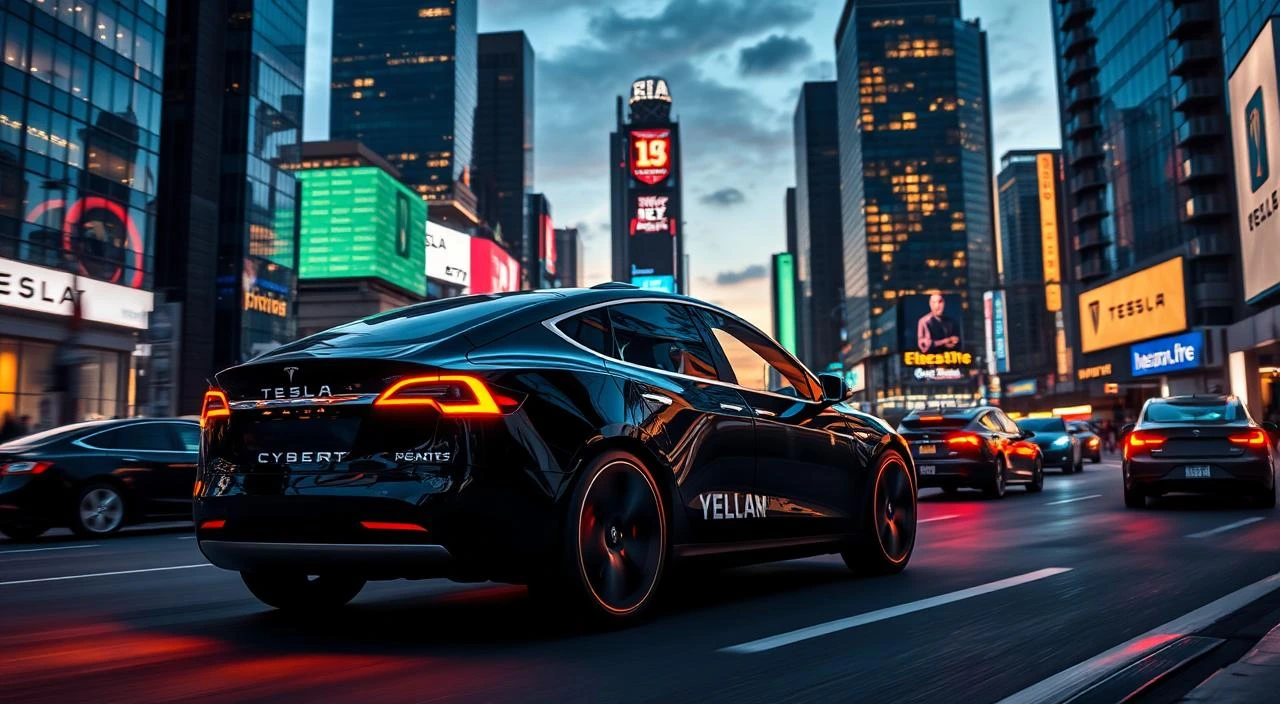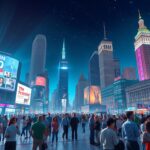Elon Musk, Tesla’s CEO, says autonomous cars will be 10-20 times safer than those driven by humans. This is the backdrop for Tesla’s newest creation: the Cybercab. It’s an electric vehicle made for self-driving, without a steering wheel or pedals.
The Cybercab has a unique design with doors that open upwards and a small cabin for two people. It could cost just $0.20 per mile, making it a cheap and easy way to get around cities. This is much cheaper than city buses, which can cost up to $1 per mile.
Tesla aims to start fully autonomous driving in Texas and California by next year. They plan to start making the Cybercab in 2026 or maybe 2027. This shows Tesla’s big plans to change how we move around with new tech.
Key Takeaways
- The Tesla Cybercab is a purpose-built electric vehicle designed for autonomous driving.
- It is expected to be 10-20 times safer than human-driven vehicles.
- The Cybercab’s cost-per-mile is estimated to be as low as $0.20, significantly cheaper than traditional city buses.
- Tesla plans to launch fully autonomous driving in Texas and California by next year and start Cybercab production by 2026 or 2027.
- The Cybercab features a futuristic design with upward-opening doors and a compact cabin for two passengers.
Introducing the Cybercab: Tesla’s Revolutionary Robotaxi
Tesla is set to introduce the Cybercab, a new electric vehicle that will change city travel. It’s a robotaxi that combines advanced self-driving tech with Tesla’s electric car know-how. This move shows Tesla’s aim to change how we travel in cities.
An Inside Look at Tesla’s Autonomous Electric Vehicle
The Cybercab will debut at the “We, Robot” event in Burbank, California. It has cool features like inductive charging, no need for charging plugs. The inside is like a lounge, making travel time relaxing and useful.
Futuristic Design and Innovative Features
The Cybercab’s design is stunning, with butterfly doors and a design made for self-driving. It has no steering wheel or pedals. This shows Tesla’s bold vision for car design and tech.
The Cybercab is a big step for Tesla in electric and self-driving cars. It brings new features and design to city travel. It’s set to change how we see and use transportation in cities.
“Tesla should be thought of as an AI robotics company, not just an automaker.”
– Elon Musk, Tesla CEO
| Feature | Description |
|---|---|
| Autonomous Driving | The Cybercab has advanced self-driving tech for safe, easy travel without human help. |
| Inductive Charging | Its inductive charging tech means no need for charging plugs, making it easy to use. |
| Compact Cabin Design | The inside is designed for self-driving, focusing on comfort and productivity for passengers. |
The Cybercab is a big leap for Tesla in electric and self-driving tech. It brings new features and design to city travel. It’s set to change how we see and use transportation in cities.
The Benefits of Autonomous Driving Technology
Autonomous driving technology, like Tesla’s Cybercab, is changing how we travel. It brings safety and saves time. Tesla plans to start its robotaxi service by late 2025. This could make our roads safer and more efficient.
Increased Safety and Reduced Accidents
Autonomous driving makes roads safer. Tesla’s Elon Musk says their cars, like the Cybercab, will be much safer than human-driven ones. If true, it could save many lives and prevent injuries.
Time Savings and Convenience
Autonomous cars also save time and make travel easier. Most cars are only used for about 10 hours a week. The Cybercab lets you use that time for work, fun, or anything else, without worrying about driving.
| Benefit | Description | Potential Impact |
|---|---|---|
| Increased Safety | Autonomous driving technology can reduce accidents by up to 20 times compared to human-driven cars. | Significant reduction in road fatalities and injuries, leading to safer communities. |
| Time Savings | Self-driving cars can be utilized for a much larger portion of the week, allowing passengers to use their time for other activities. | Increased productivity, more leisure time, and reduced stress for commuters. |
| Convenience | Autonomous vehicles like the Cybercab can provide on-demand transportation, reducing the need for personal car ownership. | Improved accessibility and mobility for individuals, specially the elderly and those with disabilities. |
As Tesla and others advance autonomous driving, its benefits are clear. The Cybercab and similar cars will change how we travel. They promise safer roads and more free time for us all.
cybercab tesla: Revolutionizing Urban Transportation
The Cybercab, Tesla’s latest innovation, is set to change urban transportation. It’s an autonomous electric vehicle designed to be affordable and easy to use. It aims to solve problems like traffic jams and the waste of personal vehicles.
Elon Musk has always talked about a fleet of robotaxis. He promised they would be ready by the end of 2020. Tesla’s “Full Self-Driving” software has been available for nine years. But, the Cybercab event, called “We, Robot,” is expected to show Tesla’s progress in autonomous vehicles urban transportation and tesla robotaxi urban mobility.
Many people think the Cybercab’s unveiling will be a big deal for Tesla. But, some doubt there will be big steps forward in self-driving tech. They point out the tough rules and safety worries that have held the industry back.
Despite these hurdles, Tesla’s idea for the Cybercab could change urban travel. It could make moving around cities easier and greener. The Cybercab wants to be a better choice than old public transport and ride-sharing, leading to a greener future.
“The Cybercab represents Tesla’s vision for revolutionizing urban transportation. By providing a cost-effective and accessible autonomous mobility solution, the Cybercab aims to address the pain points of traditional urban transportation.”
Affordable Autonomous Mobility Solutions
Tesla’s Cybercab is set to change how we move around cities. It offers affordable autonomous vehicles that are easy on the wallet. Elon Musk says it will be the cheapest and most affordable self-driving car, costing about $0.30-$0.40 per mile.
This price is much lower than city buses, which cost around $1 per mile. The Cybercab is a big step towards making transportation more accessible for city folks. Tesla uses its know-how in electric vehicles and autonomous driving technology to make mobility more affordable and inclusive.
Cost-Effective and Accessible Transportation
- The Tesla Cybercab is expected to cost below $30,000, making it a more affordable autonomous vehicle compared to traditional options.
- The operating cost of the Cybercab is estimated at around $0.20 per mile, further boosting its cost-effectiveness.
- The Tesla Robovan, capable of seating up to 20 people, is projected to have an operating cost of approximately $0.05 – $0.10 per mile, providing an even more accessible transportation solution.
- The Optimus robot from Tesla, anticipated to cost between $20,000 and $30,000, could potentially expand the reach of affordable autonomous mobility solutions.
Tesla’s Cybercab aims to make autonomous mobility more affordable and accessible. It wants to change urban transportation for the better, letting more people enjoy the perks of self-driving cars.
Tesla’s Vision for the Future of Mobility
Tesla’s Cybercab is a key part of the company’s vision for the future of transportation. CEO Elon Musk sees autonomous vehicles as a game-changer. He wants cars to be more than just a way to get from one place to another. Instead, they should be comfortable spaces where people can relax or work.
This vision fits with the broader trends in the transportation world. Companies are working on smart mobility solutions that are efficient, green, and user-friendly. Tesla has shown off 20 Cybercab vehicles, aiming for a cost of less than $30,000 and an operating cost of about $0.20 per mile. The Cybercab is designed for ride-hailing, and Tesla plans to start its Full Self-Driving (FSD) feature in Texas and California next year.
- Wordle Today: Guess the Word and Challenge Yourself
- Avalanche vs Golden Knights: NHL Matchup Analysis
Tesla’s robotaxi plan is a big part of its future plans. Musk expects the Cybercab to be ready by 2026 or early 2027. Tesla wants to take 25% to 30% of the revenue from owners who use their cars for ride-hailing. By mid-next year, Tesla hopes to have over a million cars ready for Full Self-Driving.
| Key Milestones | Timeline |
|---|---|
| Unveil 20 Cybercab vehicles | Current |
| Projected average operating cost of Cybercab | $0.20 per mile |
| Anticipated Cybercab vehicle cost | Below $30,000 |
| Start unsupervised Full Self-Driving (FSD) in Texas and California | Next year |
| Cybercab expected to be in production | 2026 or before 2027 |
| Projected Tesla vehicles with FSD hardware on the road | Over 1 million by mid-next year |
As Tesla advances in autonomous driving, its vision for the future is clear. The company is using its electric vehicle and software expertise to create a better transportation system. This system will be efficient, green, and change how we travel in the future.
Regulatory Challenges and Approvals
As Tesla introduces the Cybercab, it must tackle a tough regulatory world. The Cybercab, without a steering wheel or pedals, is a big leap in tech. But, it needs approval from many groups before it can hit the roads.
Elon Musk, Tesla’s leader, says the Cybercab might debut in 2027. This depends on how fast regulators give their okay. It shows how key autonomous vehicle regulations and self-driving car approvals are for the Cybercab’s success.
Overcoming Legal Hurdles
The tesla cybercab legal challenges are many. Tesla must make sure the Cybercab follows all transportation technology regulations and navigating autonomous vehicle laws. This includes getting the green light from the National Highway Traffic Safety Administration (NHTSA) and others.
Tesla’s way of making cars drive themselves, using just “computer vision” and machine learning, might face extra hurdles. This is because it’s different from what others like Waymo use.
“Regulatory approval will be a significant challenge for Tesla in deploying the Robotaxi and its unsupervised full self-driving technology in the future.”
Getting past these legal and regulatory obstacles is key for Tesla’s Cybercab dream. As Tesla works through this tough terrain, it must prove its tech is safe and reliable. This is to get the approvals needed and launch the Cybercab.
Cybercab’s Impact on the Ride-Sharing Industry
The Cybercab from Tesla could change the ride-sharing world a lot. It might be cheaper and more efficient than what we have now. Elon Musk wants it to be like a personal taxi service, but for everyone.
This could make big changes for companies in the ride-sharing business. They might need to rethink how they work because of the Cybercab. Some experts doubt Tesla’s tech, saying it’s not ready for the roads.
Even with doubts, Tesla’s boss Elon Musk said he’d have a fleet of self-driving cars by 2020. That didn’t happen. But, some people think it could be good for Tesla, even if its stock has dropped a lot.
The Cybercab is set to change how we get around cities. Tesla needs to solve its tech problems and get past rules to make it work. This will show how big of a deal the Cybercab really is.
| Key Factors | Impact on Ride-Sharing Industry |
|---|---|
| Cost-Effectiveness | The Cybercab’s affordable ride could shake up how much we pay for rides. |
| Efficiency | It could make getting around faster and easier, with more rides available. |
| Regulatory Challenges | Tesla’s fights with rules could slow down the Cybercab’s start in the market. |
| Autonomous Driving Technology | How well the Cybercab works will depend on Tesla’s tech, which some doubt. |
“The introduction of the Cybercab has the potential to significantly disrupt the ride-sharing industry, challenging the dominance of traditional ride-hailing services.”
Self-Driving Technology: The Road Ahead
The Tesla Cybercab marks a big step for Tesla in its quest for self-driving cars. Tesla faces legal and technical hurdles. The Cybercab’s success will show if Tesla can keep innovating in self-driving cars.
Overcoming Obstacles and Embracing Innovation
Tesla has hit bumps before, but CEO Elon Musk always finds a way. The journey to make self-driving cars common is tough. Waymo and Cruise have tested their cars for millions of miles, and the government watches their safety closely.
Despite these challenges, Tesla is all in on self-driving technology progress and autonomous vehicle mobility. The company is pushing for advanced self-driving car innovations with the Tesla Cybercab. They aim to revolutionize urban transportation with affordable autonomous solutions.
“Tesla plans for the Cybercab to go into production in 2026 and be priced at less than $30,000 eventually.”
As Tesla tackles legal and technical issues, the future of self-driving cars is uncertain. Tesla’s success in overcoming obstacles and embracing innovation will shape the future of self-driving cars and the Tesla Cybercab innovation.
Conclusion: Revolutionizing Transportation with the Cybercab
The Tesla Cybercab is a bold step towards the future of city travel. It combines advanced electric power, smart driving tech, and a sleek design. Despite challenges, its success could change the ride-sharing world and the car industry.
This car could make city travel safer, cheaper, and more efficient. It could start a new era of green and easy city travel. This meets the growing need for eco-friendly and self-driving cars.
Tesla is moving beyond just electric cars to focus on robotics and AI. The Cybercab shows Tesla’s drive to innovate and change how we move. Its launch could be a major turning point in city travel and our use of technology.
FAQ
What is the Tesla Cybercab?
The Tesla Cybercab is a new electric vehicle designed for self-driving. It was unveiled by Tesla CEO Elon Musk. This vehicle has no steering wheel or pedals and features a futuristic design.
It has upward-opening doors and a small cabin for two passengers.
What are the key features of the Cybercab?
The Cybercab prototype was shown at the “We, Robot” event in Burbank, California. It has a futuristic design with butterfly-style doors. The cabin is compact and designed for autonomous operation.
It also includes inductive charging technology, eliminating the need for a plug.
How does the Cybercab compare to human-driven vehicles in terms of safety?
Musk says the Cybercab will be 10-20 times safer than human-driven vehicles. This could save a lot of lives and prevent injuries.
What are the cost and efficiency benefits of the Cybercab?
Musk estimates the Cybercab will cost around $0.30-$0.40 per mile, including taxes. This is much cheaper than the average cost of $1 per mile for city buses.
The Cybercab is designed to be used for a larger part of the week. This allows users to use their time more productively.
What is Tesla’s vision for the Cybercab?
Musk sees the Cybercab as a form of “individualized mass transit.” It offers a convenient and efficient alternative to traditional public transportation and ride-sharing services.
The Cybercab is part of Tesla’s vision to revolutionize urban transportation and the future of mobility.
What are the regulatory challenges Tesla faces with the Cybercab?
The Cybercab, being a fully autonomous vehicle without a steering wheel or pedals, needs approval from regulatory bodies. Musk acknowledged this challenge.
He said the Cybercab’s launch could be as late as 2027, depending on regulatory approvals.
How could the Cybercab impact the ride-sharing industry?
The Cybercab could significantly disrupt the ride-sharing industry. It offers a more cost-effective and efficient autonomous transportation solution.
This could challenge the dominance of traditional ride-hailing services and force companies to adapt their business models.
What are the key challenges Tesla faces in advancing its self-driving technology?
Tesla has a history of delivering innovative solutions. But, the path to widespread adoption of self-driving technology is challenging.
Companies like Waymo and Cruise have millions of miles of on-road testing. Federal regulators are also closely monitoring the safety of these systems.
Tesla will need to overcome these challenges and continue to innovate in the autonomous vehicle space.

My name is Jakir, I am a content writer, content creator, I give business, sports, finance, trending news and I have 10 years of experience in this and this is my blog goldennews24.com.










